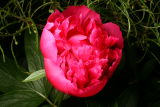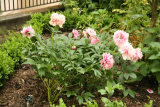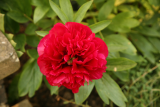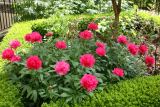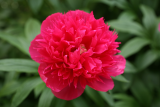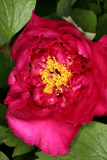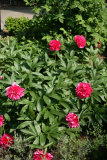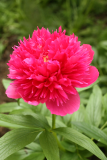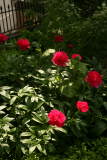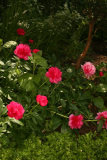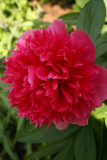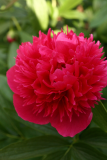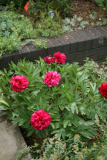Additional notes (click to expand)
Commemorative
The glorious peony, commemorates Paeon, physician to the gods of ancient Greece, who enjoyed the best private practice of the era. Homer’s Iliad v. 401 and 899 (c. 800 BC) provides further details (Murray, 1924). The name Paeon came to be associated as being Apollo, Greek god of healing, poetry, the sun and much else, and father of Aesculapius/Asclepias. Hesiod, the greatest Greek author after Homer, about a century later, clearly regarded them as separate deities, viz:
If neither Phoebus Apollo does save us from death, nor Paean who knows remedies for everything.
The Mycenaean Greeks of the late Bronze Age (1600–1100 BC) worshipped a god of healing called Paiawon, ‘a divinity with a formidable knowledge of herbs and drugs ...’ (Graf, 2009), and Apollo was not known. Paiawon’s cult disappeared after the collapse of the Mycenaean world. The fusion of Paiawon/Paeon and Apollo occurred much later as both being names for the god of healing.
Theophrastus (c. 300 BC), repeated by Pliny (AD 79), wrote that if a woodpecker saw one
collecting peony seed during the day, it would peck out one’s eyes, and (like mandrake) the roots had to be pulled up at night by tying them to the tail of a dog, with the added warning that one’s ‘fundament might fall out’ (anal prolapse) if one cut the roots with a knife. Theophrastus, I am glad to say, thought this ‘far-fetched’, as did Pliny, viz: ‘all this, however, I take to be so much fiction, most frivolously invented to puff up their supposed marvellous properties’.
Oakeley, Dr. Henry. (2012). Doctors in the Medicinal Garden. Plants named after physicians. Royal College of Physicians.
link
Horticulture
The European Paeonia officinalis, a hardy perennial of the Paeoniaceae family, and the double form ‘Rubra Plena’ grow happily in the Medicinal Garden in a herbaceous border in dappled shade. The beautiful dissected foliage, crimson flowers from April to June and striking seed pods make it a welcome addition to the garden. Both this and P. suffruticosa, which we also grow, require deep, welldrained soil. The soil was prepared thoroughly before planting and the site was chosen carefully to avoid morning sun, which can cause damage after frost. We mulch annually with well-rotted manure in spring, avoiding the crowns. Otherwise, they are best left undisturbed. (Clare Beacham)
Oakeley, Dr. Henry. (2012). Doctors in the Medicinal Garden. Plants named after physicians. Royal College of Physicians.
link
Nomenclature
OTHER COMMON NAMES: COMMON GARDEN PEONY; GERMAN VINEGAR ROSE; KING'S FLOWER; PENTECOST ROSE; ST GEORGE'S FLOWER; SCARLET MALLOW
Other use
Dioscorides (AD 70) wrote that 15 of its black seeds, drunk with wine, were good for nightmares, uterine suffocation and uterine pains. Do not try this at home even if you know what uterine suffocation might be. The roots, hung round the neck, were regarded as a cure for epilepsy for
nearly 2,000 years, a belief which was incomprehensible until I found, in Elizabeth Blackwell’s A curious herbal (1737), published with the approval of the Royal College of Physicians, that it was used to cure febrile fits in children, associated with teething (which stop whatever one does).
Paeonia suffruticosa was introduced to European horticulture by Sir Joseph Banks (1743–1820). A root extract in 25% alcohol has recently been licensed for use for the relief of menopausal hot flushing as an across-the-counter medication in Britain, despite inhibiting clotting mechanisms and
causing uterine contractions, lack of toxicity, genotoxicity or genotoxicity trials, and the absence of proof that it works (MHRA website, 2011).
Oakeley, Dr. Henry. (2012). Doctors in the Medicinal Garden. Plants named after physicians. Royal College of Physicians.
link
Geographical distribution
- Europe, Middle Europe, Hungary
- Europe, Middle Europe, Switzerland
- Europe, Southeastern Europe, Albania
- Europe, Southeastern Europe, Italy
- Europe, Southeastern Europe, Romania
- Europe, Southeastern Europe, Yugoslavia
- Europe, Southwestern Europe, France
- Europe, Southwestern Europe, Portugal
- Europe, Southwestern Europe, Spain
Paeonia officinalis L. 'Rubra Plena'
Family: PAEONIACEAEGenus: Paeonia
Species: officinalis L.
Cultivar: 'Rubra Plena'
Common names: Peony
Pharmacopoeia Londinensis name: Poeonia
Distribution summary: Europe
Habit: Perennial
Hardiness: H5 - Hardy; cold winter
Garden status: Currently grown
Garden location: Classical Europe & Middle East (I), Europe & Middle East (J), Pharmacopoeia Londinensis 1618 'Flowers' (HSE 1), Pharmacopoeia Londinensis 1618 'Roots' (HSE 3), Pharmacopoeia Londinensis 1618 'Seeds & Grains' (HSE 7), Pharmacopoeia Londinensis 1618 'Roots' (HSE 2)
Flowering months: May
Reason for growing: Commemorative, medicinal
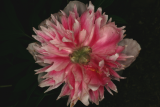

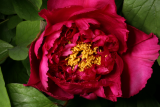
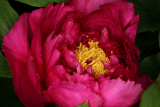
.JPG)
